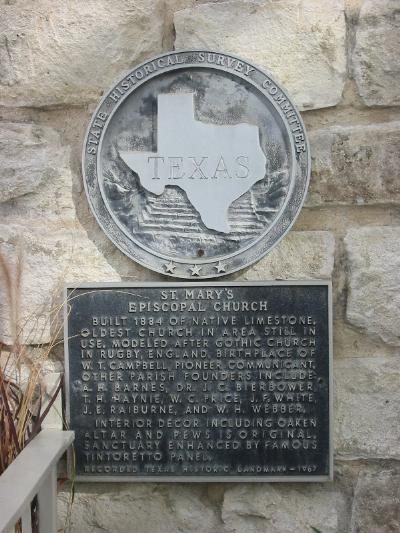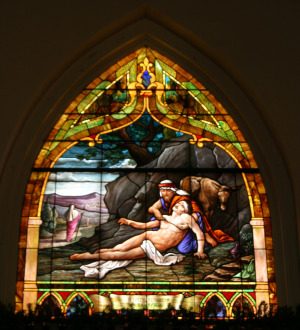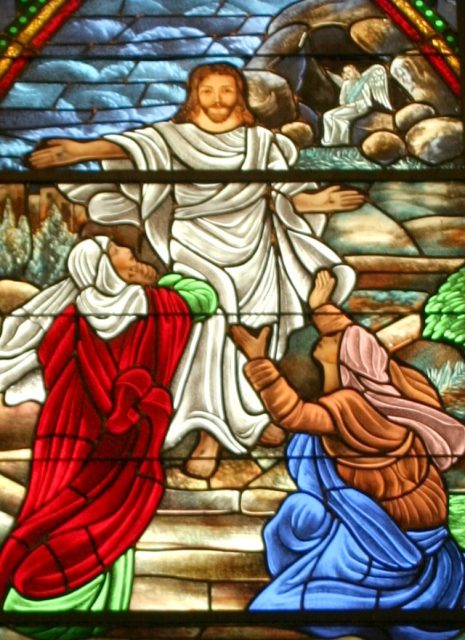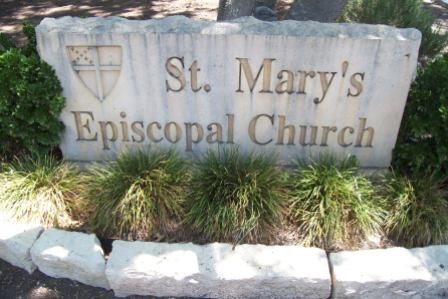ST. MARY'S EPISCOPAL CHURCH
LAMPASAS, TEXAS
The History of St. Mary’s
Written by Jane McMillin
Lampasas, Texas
March 2008

St. Mary’s Episcopal Church in Lampasas traces it origins to 1873 when the Rt. Rev. Alexander Gregg, first Bishop of Texas, licensed Dr. Thomas S. Denny as lay reader for a tiny handful of Episcopalians. Today, with 110 "baptized members in good standing”, the community of St. Mary’s can celebrate and draw inspiration from the persistent efforts and devotion of its predecessors who kept the church alive and thriving for 135 years.
When Dr. Denny arrived in the winter of 1872, Lampasas was very much a small frontier settlement still in the throes of Reconstruction, economic hard times, Indian depredations and outlawry. Denny, a medical doctor and former vestryman at St. David’s in Austin assumed his church duties in January of 1873. Just two weeks later a gunfight broke out at the Lampasas Saloon that left the local sheriff seriously wounded. Two months later another gunfight started at the same saloon when state police – who had been dispatched to Lampasas to arrest parties to the earlier fight -- were ambushed. The fight spilled out into the courthouse square; and when it was all over, four men were dead.
Three years later the bloody Horrell-Higgins Feud erupted and left at least four more dead. The feud raged on for months and included yet another gun battle on the streets of Lampasas. Such bloodshed earned Lampasas the reputation of being one of the roughest places in Texas, according to Bill O’Neal, historian of the American West and author of The Bloody Legacy of Pink Higgins.
Just how much violence actually touched the lives of ordinary citizens remains to be investigated, for the infamous decade also saw the rise of several civilizing forces. A school had already been founded in 1869, and several churches were established in the early 1870s, including Baptist, Methodist and Presbyterian as well as the Episcopal mission. The City of Lampasas was incorporated at this time, and the Farmers Alliance originated in Lampasas County as an organized political response to depressed agricultural prices.
Besides all the bloodshed during Dr. Denny’s inaugural year as lay reader, the town also suffered a devastating flood. Nevertheless, the doctor’s report to the Diocese for 1873 indicated that eight families and three “individuals not connected with families” comprised the tiny Episcopal enclave with no name -- and no church building. Denny also reported that plans were in the making for a Sunday school.
Two years later the Lampasas congregation received official recognition as mission of the Episcopal Church. However, it would take another 77 years before it secured its status as a parish.
Although there is no detailed record of where Episcopalians met for worship during their mission’s early years, there is at least one reference to services held in the county courthouse. It is also said that denominations, which had already built their churches, shared their space with others that had not yet constructed theirs. It is also likely that communicants gathered in the local schoolhouse and in private homes. It would be almost a decade before construction would start on an Episcopal church building in Lampasas.
Unfortunately records were only sketchy at best for the mission’s first 20 years. However, T.H. Haynie could well have been one of the earliest communicants. According to a family history published in Lampasas County, Texas: Its History and Its People, T. H. (Thomas Hoxey) Haynie first came to Lampasas in late 1860s. The account goes on to credit him with being part of the contingent that captured some of the Horrell boys who were fugitives from justice during their feud with the Higgins during the 1870s. Haynie would go on to be a leader in St. Mary’s and one of the men responsible for getting the church built. (See below for more information on Haynie and his descendants.)
A.H. Barnes was another who was in Lampasas at the time Dr. Denny first arrived and could have been one of the original 11 communicants Dr. Denny reported to the Diocese in 1873. (See below for more information on Barnes.)
The coming of the railroad to Lampasas in 1882 signaled the end of the town’s frontier period and the beginning of a new era of prosperity and unparalleled social change for Lampasas -- and for its small congregation of Episcopalians.
A group among the railroad’s directors and major stockholders, including George and John Sealy of Galveston, formed the Lampasas Springs Company to capitalize on the area’s mineral springs and develop the town into a fashionable health resort. The company built the large and luxurious Grand Park Hotel in 1883, and made Lampasas the leading tourist destination in Texas for a short time. The hotel’s first manager was an Englishman named Henry Holton, who joined St. Mary’s and later served as clerk of the vestry in 1893. He remained a member of St. Mary’s until he died in 1895.
The Park Hotel proved to be not only a draw for tourists, it also attracted Lampasas residents to its formal balls, concerts, Chautauquas and elegant dinners. As a result, the hotel helped set the tone for social life among local residents… such as those who built fine Victorian homes – and lavishly entertained in them -- along the street that became known as “Silk Stocking Row.” Eventually the “wild and wooly” element, which had given Lampasas such a dubious reputation in the 1870s, was subdued.
Within the context of Lampasas’ general prosperity, attention could be turned to securing a permanent home for the Episcopal mission. The cornerstone and foundation were laid in 1884, and that same year the mission got its first priest in residence. It is said that the mission was named St. Mary’s when the church was built. Notes in the historical files of the late Dr. Rush McMillin indicate that in 1884 St. Mary’s claimed 32 communicants.
The forward momentum of the church’s construction was short lived, however. When the railroad built farther west in 1885, Lampasas’ boom went bust. A slow economy and a severe drought made money scarce; and the church still labored under its debt. It would be six years before St. Mary’s was finished.

It is said the design of St. Mary’s was inspired by a church in Rugby, England, boyhood home of pioneer communicant W.T. Campbell. It is possible the legend has some merit, however more investigation is needed.
Described as Victorian Gothic in style, St. Mary’s is built on a simple rectangular plan with the altar at the east end. It has a steeply pitched roof, and pointed arch windows pierce the walls of native limestone. The entrance is through a crenellated bell tower that doubles as a narthex. Two large round windows toward the top of the bell tower provide examples of the simple colored glass that was originally used throughout the building. The rest of the windows have been replaced through the years by exquisite stained glass panels that have been given as memorials. Most of these windows were made either at mid-twentieth century or earlier.
Five out of 18 memorial windows honor those who are generally considered the main leaders in the effort to build St. Mary’s Church. Five other windows (counting one in the church office) memorialize various relatives of the church’s “founding fathers.”
Among those credited as instrumental in the building of St. Mary’s are as follows:
A.H. Barnes, The land on which St. Mary’s was built was part of the A.H. Barnes addition to the Old Town Lampasas (the city’s original tract). Alexander Hamilton Barnes conveyed a parcel of his tract to Bishop Gregg in Sept. 1882. Capt. Barnes, a Civil War veteran turned real estate developer, was senior warden when the church cornerstone was laid in 1884. He came to Lampasas in 1871 and was married here that same year. He died in 1894.
Dr. James Culver Bierbower, a dentist who practiced in Lampasas at least by 1884. Served as Senior Warden. Died in 1891.
W.T. Campbell, a native of England who came to Lampasas in the late 1880s and established a new newspaper, the Lampasas Leader. Also dealt in real estate and the buying, warehousing and selling of grain. At the urging of former Texas Gov. James S. Hogg, Campbell entered the oil business in 1901 after oil was discovered near Beaumont. He eventually sat on the first Board of Directors of The Texas Company, which became Texaco. Died in 1906.
T.H. Haynie, Born in the Republic of Texas. Came to Lampasas about 1868. Emerged as a church leader at least by 1884, when serving as church treasurer at the time the cornerstone and foundation were laid. Served as senior warden from 1901 to about 1912 and was a lay reader for many years. At various times he also served the community at large as Postmaster of Lampasas, Lampasas County Commissioner and Tax Assessor-Collector. Died in 1917.
W.C. Price, Born on the island of Ceylon to English parents. Came to Lampasas about 1885 from San Saba County, where he had a sheep ranch. Veteran of the grain, hide, wool and pecan business. One of the organizers and for a time one of the managers, of the Texas Trading Company, one of the largest general merchandise houses in the area. He died in 1905.
J.E. Raiburne, clerk of the church in 1884.
W.H. Webber, Postmaster of Lampasas for more than 20 years. Once editor of the People’s Journal, The Voice of the Populist Party in Lampasas. Died in 1926.
Jerry F. White, A native of Virginia. Came to Lampasas in 1885 and worked in the mercantile trade. Entered the banking industry. Was cashier of the First National Bank and married the president’s daughter, Helen Skinner. Helped organize the People’s National Bank in 1905 and served as its president for 20 years. Became the largest landholder in Lampasas County. His house still stands at 604 S. Broad. Died in 1932.
During the remainder of the 1890s the number of communicants ranged from a low of 20 to a high of 71. At century’s end the number stood at 22.
The New Century
St. Mary’s has benefited greatly from two fortunes that were amassed after the first Spindletop gusher blew in near Beaumont in 1901. From the Campbell family’s share in Texaco, the church has received – among countless other things – many of its beautiful stained glass windows, the parish house, and an addition to it that housed St. Mary’s Episcopal kindergarten during the mid 1960s and into the 1970s.

In addition to monetary gifts, Campbell family members have devoted years of service to the church. In each generation there has been a Senior Warden, beginning with W.T. Campbell’s term in 1895. His son, Villard, spent two decades in the office. Villard’s son, Henry, was senior warden in 1952; the year St. Mary’s became a parish. Finally, Henry’s daughter, Mimi, was chosen to serve in 2004. Within the past few years, Mimi’s nephew and two nieces were confirmed at St. Mary’s, making the fifth generation of Campbell communicants.
St. Mary’s other “big oil” connection came through W.T. Campbell’s daughter, Sarah Jane “Sadie” Blaffer, who married one of the founders of Humble Oil and Refining (now Exxon-Mobil). One of Mrs. Blaffer’s great loves was fine art. Although her father died in 1906, Mrs. Blaffer’s mother, Sarah Jane Campbell-Scott remained a faithful member of St. Mary’s and was a generous donor until her death in 1951.
The family of T.H. Haynie also merits special mention, because three of his direct descendants are presently active in the church. Charlotte Haynie is an altar guild member of longstanding. Her daughter, Tulisha Carson, is presently a member of the vestry, co-treasurer of the church, and Sunday school Superintendent. She also has served as Senior Warden in recent years. Tulisha’s daughter, Abbie is now an acolyte. Abbie’s brother Travis is now away at school, but in his younger years, he too was an acolyte.
The “Roaring 20s” brought Tom and Annie Lois Richey to St. Mary’s, and they remained members until their deaths in the 1970s. Mr. Richey was a giant in the wool and mohair industry, with a string of warehouses from Lampasas to Sonora. He bought wool and mohair from the producers, and then sold it directly to mills in Boston and in England. It is said that at one time Tom Richey bought so much wool, that by himself he could set the price of the commodity. The industry was a major economic force that lasted into the 1970s, when synthetic fabrics gained dominance in the market.
Special mention should be made of the Richey’s daughter, Mrs. Ann Richey Oliver. Her membership in St. Mary’s spans more than 80 years, the longest of anyone in the church. To honor the longevity of her membership and many years of service on the Altar Guild, the family gave the stained glass window above the sacristy door.
A “cradle Episcopalian,” Mrs. Oliver was born and baptized in 1924. Shortly after WWII she was married in the church to Laurie Oliver, a rancher from San Saba. Ann and Laurie brought her children up in St. Mary’s during the 1950s and ‘60s. (Son Robert is presently on St. Mary’s vestry.) After Laurie’s death in the early 1980s, she continued to watch three of her grandchildren reared in the church. To honor Laurie’s memory the family gave the stained glass insets in the double doors between the bell tower and the nave. The panels, inspired by the hymn, “All Things Bright and Beautiful,” depict a Lampasas County ranch scene.
The next watershed event in St. Mary’s history was when the mission became a parish in 1952, almost 80 years after Dr. Denny first arrived in Lampasas to help a few lone Episcopalians form a mission on the Texas frontier. Membership figures showed that St. Mary’s parish had 69 communicants. Perhaps the final triumph in St. Mary’s struggle, which lasted for the greater part of a century, came from the strength of its families.
A document entitled “Signers of the Articles of Association Upon the Occasion (of) St. Mary’s Mission Becoming a Parish” now seems a testament of endurance and continuity. There are, as would be expected, signatures of members of the Campbell family. However, the document also shows that Miss Elaine Webber and Miss Cynthia White also signed articles. Their fathers, W.H. Webber and J.F. White, were among those who are honored for their work in getting the church built. Mr. L.E. Davis, presently a communicant, signed the articles, as did Mr. and Mrs. Lee Pool, parents of Mrs. Linda Joseph, who is now on the vestry.
Five years after St. Mary’s attained its status as a parish, disaster struck in the form of a flash flood during which a 10-foot wall of water crashed through Lampasas’ downtown area. St. Mary’s was only about three blocks away. Although water did get in the church, the only irreparable damage was to the floor. It had to be replaced, but other fixtures such as the pews, which were original to the church, survived relatively unscathed.
While the remainder of 20th century was spent in social turmoil throughout much of the nation, Lampasas remained relatively calm. Even racial integration of the public schools did not create a stir. However, a significant demographic revolution was beginning to build in the eastern portion of Lampasas County, the part closest to Fort Hood.
Established in 1942 as a World War II training facility for soldiers going overseas, Fort Hood became one of the world’s largest military bases in terms of area. As the installation continued to grow in area and in troop strength, the population in nearby towns and rural areas also started to grow in numbers and diversity. By about 2005, the growth rate had accelerated at such a pace, the U.S. Bureau of the Census declared Lampasas County as having the sixth fastest growth rate in the nation.

In recent years St. Mary’s also has grown in numbers and diversity, while a dozen or more families remain that can gauge the tenure of their membership not so much in years as in generations. For the challenges of changing times ahead, St. Mary’s has the opportunity to draw on a valuable mix of new ideas and fresh approaches that can be tempered by the stability and continuity of its traditions.
